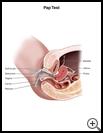
Pap Test: Teen Version
________________________________________________________________________
KEY POINTS
- A Pap test is a screening test done during a pelvic exam to check for abnormal changes in the thin layer of cells that cover the cervix or vagina.
- Schedule your Pap test between menstrual periods. Don’t douche, use creams or medicines in your vagina, or have sex for a day or two before the test.
- If the test result is normal, you don’t need follow-up tests or treatment. If the test result is abnormal, ask your healthcare provider what types of abnormal changes were found and what follow-up tests you might need.
________________________________________________________________________
What is a Pap test?
A Pap test is a screening test done during a pelvic exam. It checks for abnormal changes in the thin layer of cells that cover the cervix or vagina. The cervix is the lower part of the uterus that opens into the vagina. The vagina is the birth canal.
The Pap test is also called a Pap smear or cervical smear.
Why is this test done?
This test is done to check for cervical cancer or precancerous changes in the cells called cervical intraepithelial neoplasia (CIN). Cervical cancer can be prevented if abnormal cells are found and treated before they become cancerous. Regular screening with Pap tests has reduced deaths from cervical cancer.
The Pap test may also detect vaginal infections such as yeast infections, bacterial vaginosis, or trichomonas.
A human papillomavirus (HPV) test may be done at the same time as the Pap smear, using the same cells or different cells taken from your cervix. HPV infection can cause cervical cancer.
How often should I have a Pap test?
You should have your first Pap test at age 21, even if you are not sexually active. Then you should have a Pap test at least every 3 years until you are 65. You may need more frequent Pap tests if there are things that put you at a higher risk for cervical cancer or if you have had abnormal Pap tests.
You and your healthcare provider can decide what testing schedule is right for you. Your healthcare provider may also recommend a pelvic exam every 1 to 3 years. A pelvic exam is a checkup of your female organs, which include the vagina, cervix, uterus, fallopian tubes, and ovaries.
How do I prepare for this test?
- Don’t schedule your Pap test during your menstrual period. The best time to schedule the test is when you are between periods.
- Don’t douche for at least 2 days before the test.
- Don’t use any creams or medicine in your vagina for at least 2 days before the test unless your healthcare provider tells you to.
- Don’t have sex for 1 or 2 days before the Pap test because it can affect the results.
How is the test done?
A Pap test takes only a few minutes and is done during a pelvic exam. You will lie on your back on the exam table with your knees bent and the heels of your feet in stirrup heel holders. Your healthcare provider will put a small tool called a speculum into your vagina to hold the vaginal walls open during the exam. Your provider will use a small, soft brush to take a few cells from the cervix. The cells will be sent to a lab for testing.
The Pap test is not painful, but you may feel some discomfort when the speculum is put into your vagina.
What does the test result mean?
If the test result is normal, you don’t need follow-up tests or treatment.
If the test result is abnormal, ask your healthcare provider what types of abnormal changes were found and what follow-up tests you might need.
Test results are only one part of a larger picture that takes into account your medical history and current health. Sometimes a test needs to be repeated to check the first result. Talk to your healthcare provider about your result and ask questions such as:
- If you need more tests
- What kind of treatment you might need
- What lifestyle, diet, or other changes you might need to make
Last modified: 2019-10-07
Last reviewed: 2021-12-21

